Since the Pet Travel Scheme (PETS) was relaxed in 2012, pet travel has increased year on year. This, in combination with expanding European parasite distributions, increases the risk of pets and their owners encountering these agents while abroad, and bringing them back to the UK. In addition, legal and illegal importation of pets are also increasing the likelihood of novel parasites being introduced. Part of this trend has been driven by pets being rescued from abroad and then being rehomed in the UK.
Novel parasites may establish in the UK in a number of different ways:
The rapid identification of parasitic infection and disease in travelled pets forms an essential part of preventing new parasites and vectors establishing in the UK through these routes.
As a result of the ongoing risk that imported parasites represent to individual pets, owners, the wider public and UK biosecurity, The European Scientific Counsel for Companion Animal Parasites (ESCCAP) UK & Ireland recommend four key steps when dealing with imported pets on arrival in the UK. These are the ‘four pillars’:
Without an understanding of what parasites are arriving in the UK on imported pets and their likely clinical presentations, the potential for early detection of exotic clinical infection and early diagnosis and treatment is lost. Veterinary nurses form a vital part of the practice team in this identification process, as imported pets may first be presented through nurse-run parasite and new pet clinics. Nurses should therefore familiarise themselves with typical presentations of exotic parasitic diseases and the fundamentals of tick identification.
Exotic ticks and tick-borne diseases
Recent recorded cases and risk of establishment
Pockets of the tick D. reticulatus have been long established in the UK in West Wales, Devon, Essex and London (Medlock et al, 2017). D. reticulatus is the vector for B. canis — a cause of potentially life-threatening anaemia in dogs. While B. canis had been absent from the UK, D. reticulatus present an opportunity for B. canis to become endemic if introduced through travelling dogs returning from abroad or pet imports that may be infected or carrying infected ticks.
This risk has become reality with an endemic foci of B. canis infection establishing in Harlow, Essex, with B. canis being confirmed in local Dermacentor ticks and in untravelled dogs (Phipps et al, 2016). Further untravelled cases were confirmed in Romford in 2016 and Ware in 2017 (Woodmansey, 2017). Rhipicephalus sanguineus ticks (capable of carrying a wide range of tick-borne diseases pathogenic to dogs including Ehrlichia canis, Anaplasma platys, Hepatazoon spp. and Babesia vogelli) are frequently being found on travelled and imported dogs.
The big tick project, examining dogs across the UK for ticks, found that of all the dogs that had travelled in the 2 weeks prior to their inclusion in the study, 30.2% were infested with R. sanguineus (Abdullah et al, 2016). ESCCAP UK & Ireland has also seen an increased number of Ehrlichia canis cases reported in travelled dogs in 2017 (Stokes and Wright, 2018). Although it is unlikely that R. sanguineus would currently establish outdoor endemic populations in the UK, it can complete its life cycle in 3 months, which has allowed it to infest UK homes in a similar way to fleas. This is a concern, as these ticks may also carry zoonotic pathogens such as Rickettsia conorii, which is the cause of Mediterranean spotted fever.
Records of R. sanguineus received by Public Health England's Tick Surveillance Scheme (TSS) are increasing each year and, in the past 2 years, there have been two confirmed house infestations (Hansford et al, 2017). A Hyalomma lusitanicum tick was also recently found in the UK on a dog that had returned from Portugal. This species of tick is a potential vector of Crimean-Congo haemorrhagic fever virus (CCHFV), which is highly pathogenic to people and has also been confirmed by polymerase chain reaction (PCR) in ticks in Spain (Hansford et al, 2016; Cajimat et al, 2017). Ixodes spp. ticks, while already endemic across the UK, may be carrying tick-borne-encephalitis — another life-threatening zoonosis. Its presence in imported pets or Ixodes ricinus ticks presents a risk of it establishing in the UK in the endemic Ixodes spp. population.
Clinical signs
Nurses should be vigilant for clinical signs associated with imported tick-borne disease, which can then be referred to a veterinarian for further investigation. Some common clinical signs are:
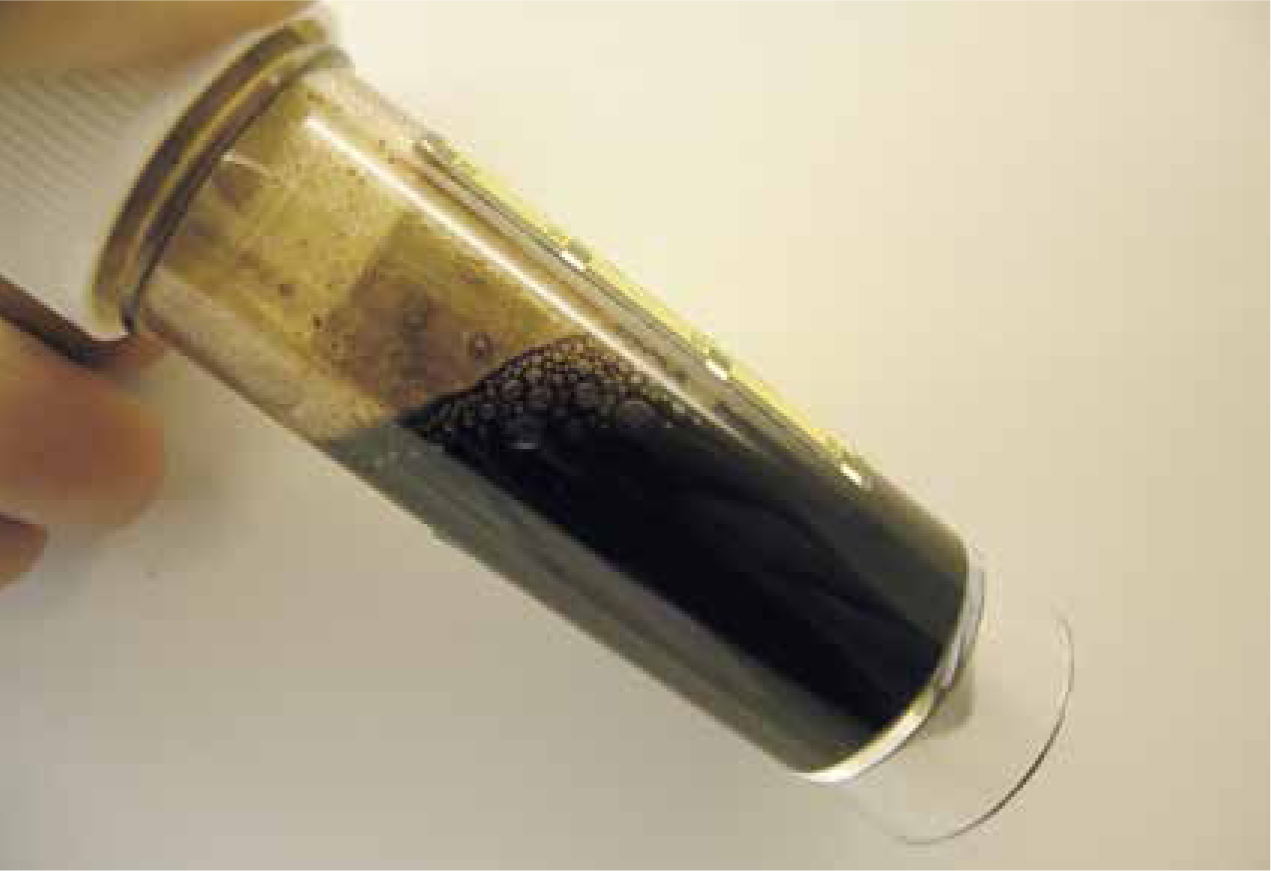
Removal of ticks and identification
Ticks should be removed with a tick removal device, e.g. a tick hook or fine-pointed tweezers. If tweezers are used, the tick should be removed with a smooth upward pulling action. If a tick hook is used, a simple ‘twist-and-pull’ action is employed. Compressing or crushing ticks in situ with blunt tweezers or fingers will stress the tick leading to regurgitation, emptying of the salivary glands and potential increased disease transmission. Traditional techniques to loosen the tick such as the application of petroleum jellies and burning will also increase this likelihood and are contraindicated (Due et al, 2013).
Adult ticks can be examined by the naked eye to identify gross features. Anatomical features can be examined more closely under a dissecting/stereo microscope; x10 or x40 magnification, using ‘top’ incident light. The tick may be mounted on a small circle of Blu Tack for easy manipulation under the microscope.
Larval ticks and nymphs are smaller and will require microscopic examination for identification. They can be placed in a drop of water or liquid paraffin on a slide, under a coverslip. Features can then be examined under a x4 or x10 objective lens.
The first step in identification is to confirm that the ectoparasite is a tick and not a mite. Adults and nymphs are usually large enough to distinguish them on size. Larval ticks are similar in size but only have six legs, and have mouthparts that are unique to ticks known as a hypostome (Figure 2).
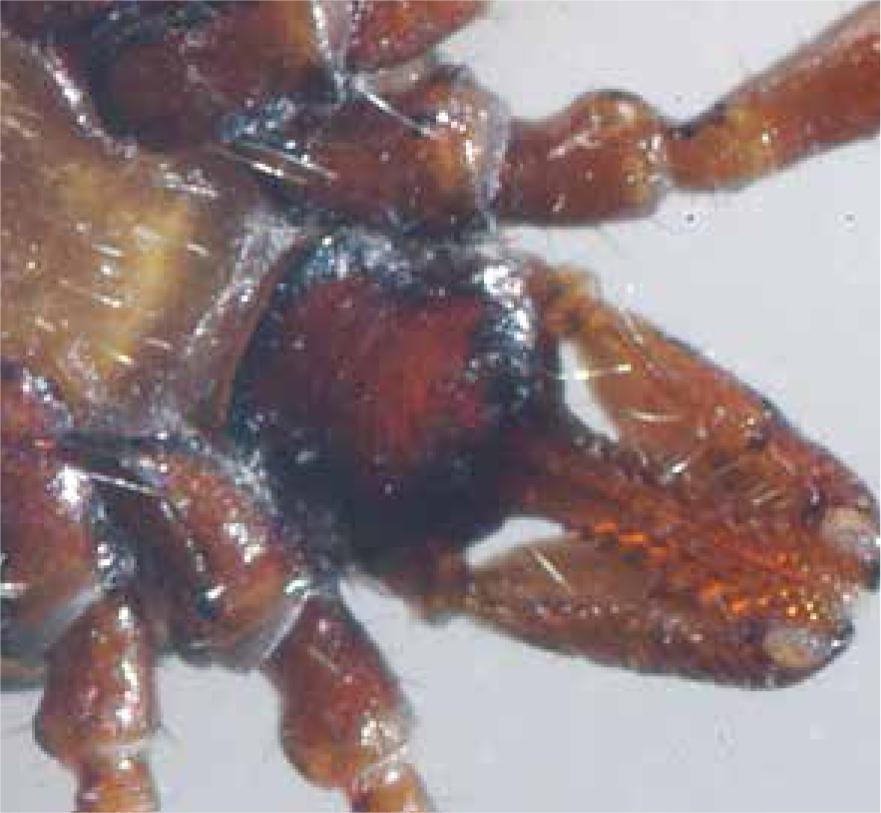
Male ticks can be distinguished from females by differences in the size of their dorsal plate or scutum. In males, this covers the entire dorsum of the tick; whereas females have a scutum that only extends a short way dorsally. This allows the abdomen to expand during feeding.
Ixodes spp. ticks can be differentiated from other genera of ticks by the anal groove; in Ixodes ticks, this is anterior to the anus (Figure 3). They also lack any decoration possessed by other ticks. Dermacentor and Rhipicephalus spp. have a groove posterior, and no groove anterior, to the anus. In addition, these ticks and other exotic genus such as Hyalomma have decorations that can be used for identification such as festoons, eyes and decoration on the scutum. Festoons are crimping around the edge of the abdomen giving a ‘Cornish pasty’ type appearance (Figure 4). Eyes are spots that are present symmetrically on either side of the scutum.
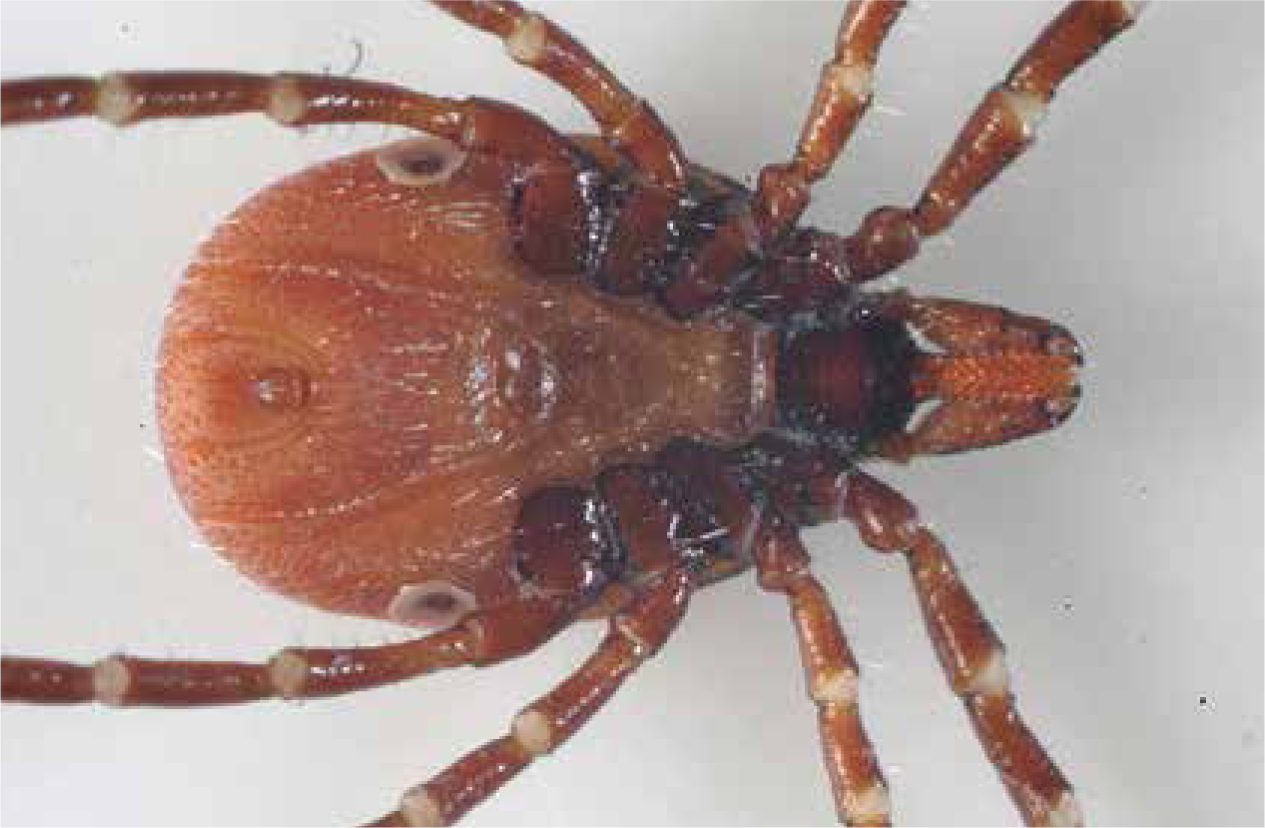
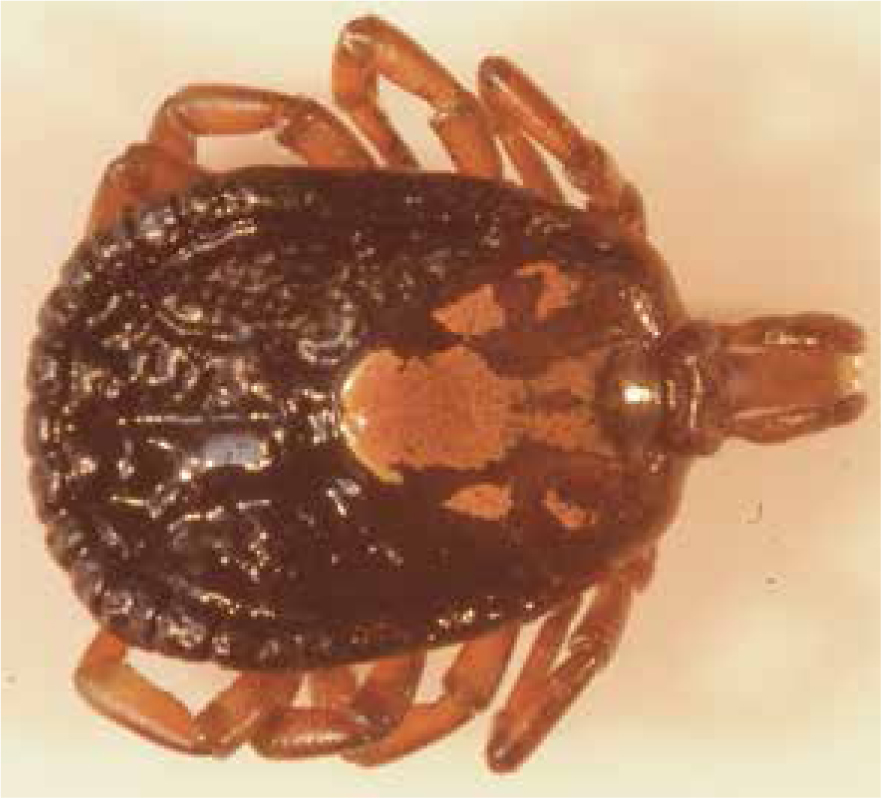
Ticks can be identified to genus using these features using the University of Bristol tick identification site (http://www.bristoluniversitytickid.uk). Alternatively, Public Health England is happy to receive ticks for identification. Ticks should be placed in a container with a secure lid and sent in an envelope marked ‘biological sample’. Samples should ideally be unfed or only partially engorged as features on the scutum and festoons may be obscured in fed ticks. More information can be found on the Gov.UK website (https://www.gov.uk/guidance/tick-surveillance-scheme).
Leishmania infantum
Recent recorded cases and risk of establishment
The sand fly vector for L. infantum is not present in the UK; endemic establishment is therefore unlikely. However, as was mentioned previously, this has occurred in countries with no sand fly vector such as Canada purely through venereal and congenital transmission. ESCCAP UK & Ireland have seen an increased number of L. infantum cases reported in travelled dogs in 2017 (Stokes and Wright, 2018).
Clinical signs
Leishmaniosis is chronic in nature with a variety of presentations and periods of remission. Signs, caused by immune complex deposition in various organs, include:
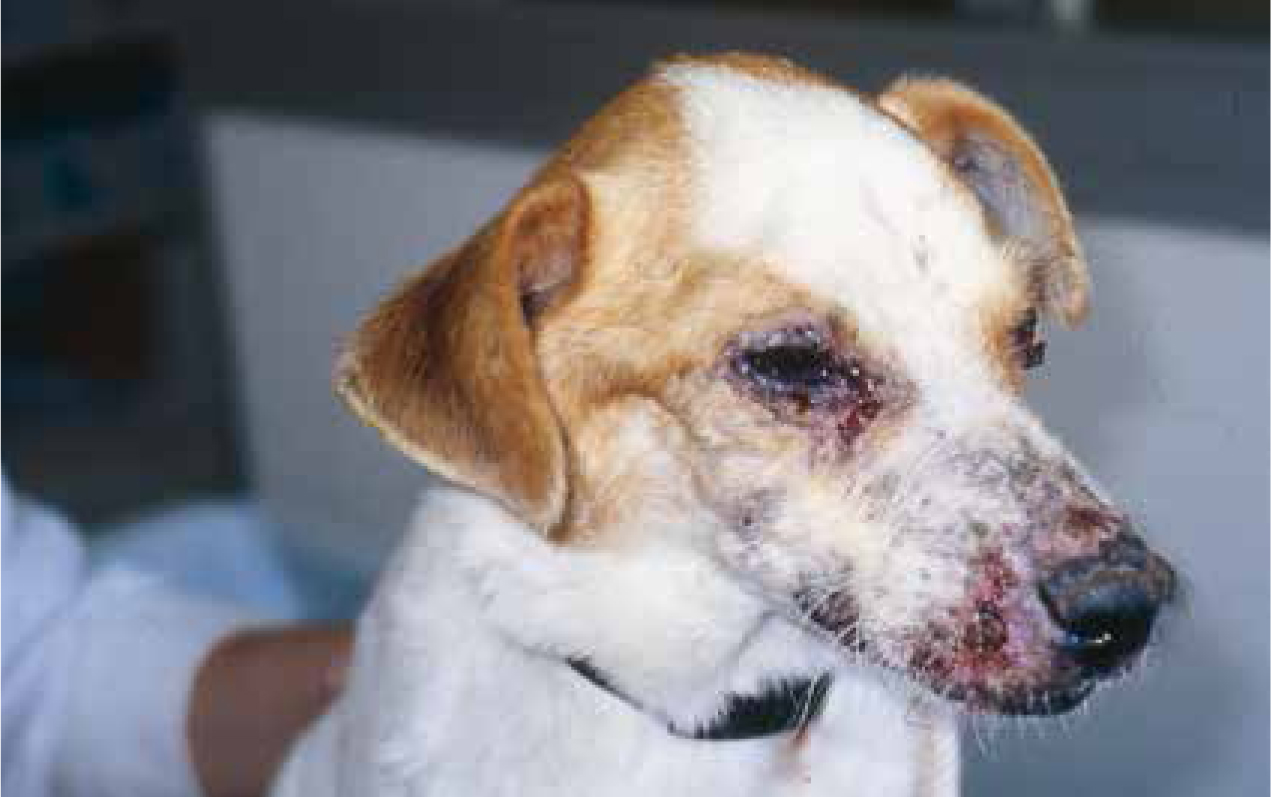
Less commonly, polyarthritis, thrombocytopenia, ocular inclusion bodies, uveitis and neurological signs associated with spinal and CNS granulomas may be present. Leishmaniosis should be considered as a differential in imported cats and dogs, as well as those with travel history. Signs may take months or years to develop so foreign travel may not be recent. Infected pets may be subclinical, and mixed infections with tick-borne pathogens are common. This means that a pet positive for Leishmania infection may have other infections responsible for presenting clinical signs. An association between leishmaniosis and feline leukemia virus/feline immunodeficiency virus (FeLV/FIV) has been recognised in cats and should be tested for in cats suffering from signs associated with clinical leishmaniosis. Cats may also present with hepatic and gastrointestinal signs.
Thelazia callipaeda
Recent recorded cases and risk of establishment
Thelazia callipaeda is a vector-borne eye worm with hosts including dogs, cats and humans. The first confirmed cases in the UK were recently recorded in dogs imported from Romania, Italy and France (Graham-Brown et al, 2017). Should T. callipaeda be introduced to the UK, its primary fruit fly vector, Phortica variegata, has been recorded in the UK with conditions favourable for spread (Graham-Brown et al, 2017).
Clinical signs
Although often subclinical, ocular thelaziosis can commonly cause conjunctivitis, keratitis, epiphora, eyelid oedema, corneal ulceration and, in serious cases, blindness. Close examination of the conjunctiva will often reveal worms actively moving on the surface (Graham-Brown et al, 2017). Checking is vital in imported cats and dogs to detect low-grade or subclinical infections to prevent vector exposure.
Dirofilaria repens
Recent recorded cases and risk of establishment
The first cases of the skin filarial nematode, D. repens were recently confirmed in UK dogs imported from Corfu and Romania (Wright, 2017; Agapito et al, 2018). While not highly pathogenic, D. repens is a zoonosis and could be transmitted by mosquitoes endemic in the UK. D. repens infection in dogs appears to be spreading across Europe, with a corresponding increase in zoonotic cases. If infected dogs continue to enter the UK and are not treated quickly, there is a possibility for UK mosquito populations to be exposed to the parasite and for the disease to become endemic.
Clinical signs
Cases of D. repens infection are most commonly subclinical but clinical signs associated with infection can occur. Dermatitis is the most common clinical presentation as multifocal nodules in the skin or papular dermatitis. These signs can reoccur seasonally for years after infection resulting in pruritus, erythema, papules and focal or multifocal alopecia. Less commonly, hyperkeratosis, crusting, distinct nodules, acanthosis and secondary pyoderma can occur. Signs may also develop from migration of worms to other parts of the body including conjunctivitis, anorexia, vomiting, fever, lethargy and lymphadenopathy. These signs are partially immunemediated in nature and partially a result of disruption and irritation caused by the physical movement of the worms. Ocular migration of worms into the vitreous is uncommon but does occur; D. repens should therefore be considered as a differential if worms are visualised there, as well as in dogs that have travelled abroad presenting with dermatitis.
Linguatula serrata
Recent recorded cases and risk of establishment
A number of nasal pentastomid Linguatula serrata (tongue worm) cases have been seen in the UK over the past 2 years from dogs imported from Romania (Mitchell et al, 2016; Figure 6). Infection is acquired from the consumption of raw meat and offal in endemic countries. L. serrata is a zoonotic infection with humans acting as intermediate, as well as definitive, hosts; they may therefore become infected through the ingestion of eggs from nasal secretions and faeces.
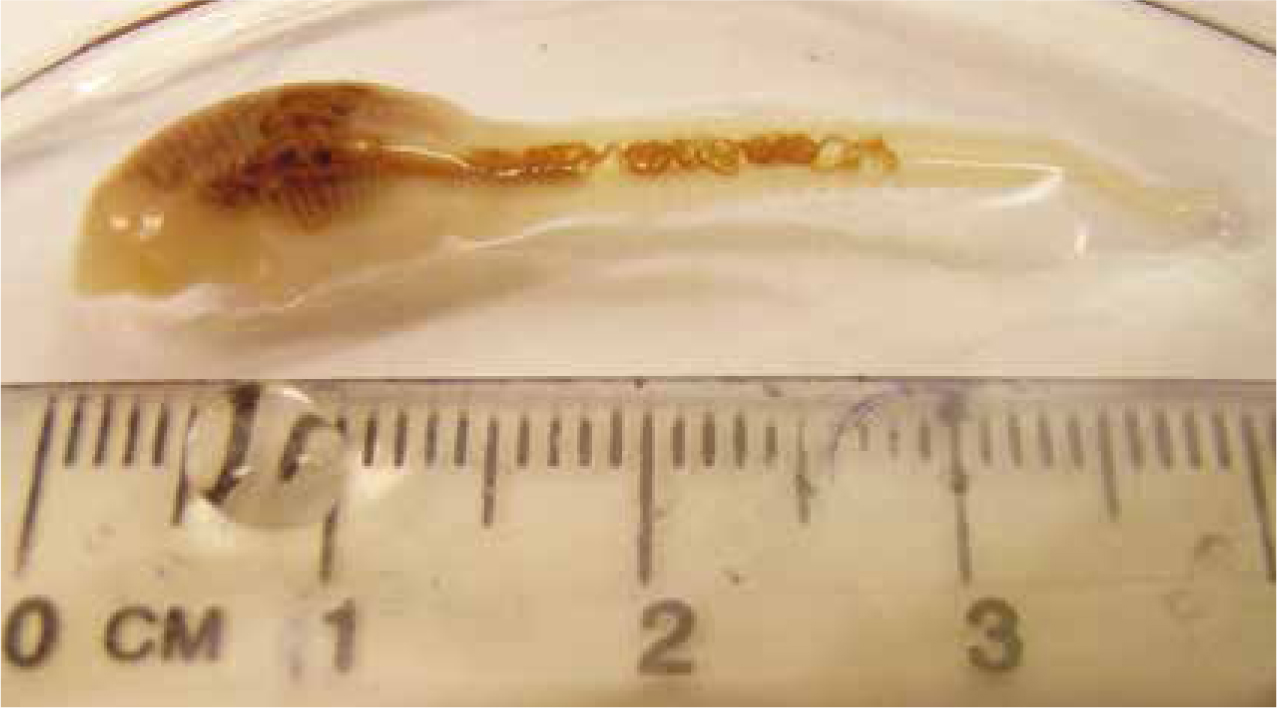
Clinical signs
Most cases of infection in dogs and cats are subclinical. However, large burdens can lead to rhinitis and nasopharyngitis with associated chronic sneezing and/or coughing, purulent nasal discharge and epistaxis. It is vital that these signs are detected early in affected dogs in order to limit zoonotic exposure to owners and others in contact who may ingest infective eggs in nasal discharge or from faecal contamination.
Dirofilaria immitis (heartworm)
Recent recorded cases and risk of establishment
Reported cases in imported and travelled pets are not as common in the UK as E. canis and L. infantum (Stokes and Wright, 2018). Risk of establishment is also currently low because although mosquitoes capable of transmitting the parasite are present in the UK, the climate has been too cold to allow D. immitis to complete its life cycle. Climate change, however, may allow establishment in the future. Recognition of clinical signs is also important to initiate appropriate treatment in the affected patient.
Clinical signs
Coughing, tachypnoea, dyspnoea and exercise intolerance are the most common clinical signs seen in infected dogs. Acute clinical signs are associated with thromboembolism, subsequent pulmonary hypertension and Caval syndrome. Worm death can also lead to thromboembolism and anaphylaxis. Typical resulting acute clinical signs include sudden death; anorexia; weakness; dyspnoea; vomiting; and, rarely, respiratory signs linked to pleural effusion.
Chronic signs are sometimes caused by inflammatory responses that are respiratory in nature, and include coughing; dyspnoea; anorexia; vomiting; and, rarely, chylothorax. Chronic respiratory signs tend to be more common in cats.
Conclusion
By being aware of the clinical presentations of the potentially imported parasites discussed in this article, further investigation can be performed, and treatment initiated from an early stage. This will often improve prognostic outcomes for the present but will also limit spread, potential UK establishment, and zoonotic exposure.
Having identified possible relevant clinical signs, countries visited can be identified and potentially relevant parasites considered. Parasite distribution maps are available from the ESCCAP UK & Ireland website (www.esccapuk.org.uk). It must also be considered however that the rapidly changing distribution of these parasites means that they may be present outside of areas covered by even the most recent distribution maps.

